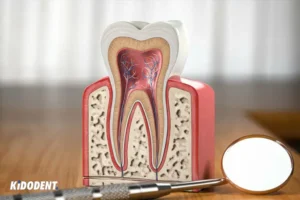At the end of orthodontic treatment, orthodontists use a retainer to prevent the teeth from moving back to the previous position or stop relapse in medical terms. So, retainer means retention and here it refers to the finishing process of each orthodontic treatment to fix the tooth movement that has occurred in its place so that teeth can’t go back to the position before the orthodontic treatment.
Why are retainers necessary?
It is interesting to know that due to the structure of the periodontal ligament (PDL), which is a collagen fiber structure, tooth movement is made possible through orthodontics. Once these teeth’ movement process is in progress, pressure or occlusal forces against the teeth can disrupt the PDL. Therefore, at the end of the orthodontic period, you need retainers to prevent those forces and pressure that might change the position of your teeth again.
There are also collagen and elastic fibers in the human gingiva that allow these teeth movements. Otherwise, the movement of teeth would not be possible to do. Due to this elasticity structure in our gums, a relapse to the original position of teeth is also possible. This is why we need a retainer after our braces or Invisalign to maintain the aligned teeth in place.
What are the different types of retainers?
- Permanent (fixed) retainer: Permanent retainer or bonded retainer is a stainless steel wire that is bonded to the back (lingual surface) of the upper or lower front teeth. Also, a permanent retainer can easily keep the teeth together after your braces, preventing shifting, gaps, and crowding.
- Removable retainer: Removable retainer can be removed while eating or brushing. Removable retainers include common orthodontic appliances like Hawley retainer, Essix retainer, tooth positioners, Moore retainer, and vacuum-formed retainer. For example, the Hawley retainer has multiple functions in orthodontics. Besides being a retainer, it also works as a space maintenance tool and a corrective device. Especially for children who have lost anterior teeth, the Hawley retainer with dentures (attached false teeth on the device) can save your child’s smile until they are old enough to have implants.
Removable or fixed retainer, which one is suitable?
There are times that we need to wear a removable retainer or have the fixed retainer bonded to our teeth depending on our teeth’ condition after the orthodontics. For example, when there are many missing teeth next to each other or adjacent teeth, as in the case of adults, the best retainers is removable with prosthetic teeth. Because of the larger missing area, these denture retainers can save space for later implants or bridges to fit well with enough space in the gum.
A permanent retainer is the best option for gap closure retention because of the possible opening of the gap in the diastema after the removal of the orthodontic appliance. To prevent possible damage to the gums, the permanent retainer is the best option. It is because of possible force and pressure from the removable retainer that may put gum under some pressure.
How long should I wear a retainer?
The time for a retainer can extend to months and years, and it depends on the type of treatment you had. First, it is necessary to wear the permanent retainer full-time, and then you may continue with either a removable or permanent retainer. The rule of thumb is as long as teeth require retention and there is a risk of teeth moving back, there should be retainers on. Follow your orthodontic instruction on the exact time frame for retainers. You may have had severe irregularities or just less crooked teeth. Therefore, the type of orthodontic treatment that you have undergone is also important in orthodontic retention.
Depending on whether the patient is in the growing stage (children) or is an adult, the retainer should be worn for a longer or shorter period of time. This again comes to your orthodontist’s idea on the best length of the period for wearing a retainer.
Cleaning teeth during the retainer
With a permanent retainer, you may find flossing or brushing a little difficult, but careful flossing technique and brushing gently can prevent plaque formation and tooth decay in teeth.
Removable retainers need much more care. Children especially may lose the retainer or even may break them while playing. Cleaning teeth and mouthwash use should be a regular and daily routine. You should follow oral health tips as with permanent retainers but keep in mind that removable retainers can be taken out and make no problems with brushing and flossing.
